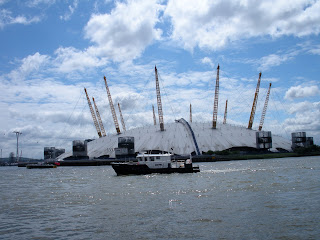The day after the pageant, I went back to West India Dock and went part of the way home on Galatea.
Here we are heading towards the lock. The grey building on the left, behind Morpheus, is the old Independent office at South Quay.
As we were sitting waiting for the lock to load (it can hold dozens of boats), the sun came out. It felt as if it was patting us on the head, and saying: "Well done!"
Some of the boats in the lock with us were quite tall, so when the lock gates opened onto the Thames, the bridge had to go up too. When we worked at South Quay, my Independent colleagues and I used to go to a pub called The Gun, opposite the Dome. We never had time for a long lunch, but if the bridge was up (to let a big boat into West India Dock), we couldn't get back to the office. The only option was to go back to the pub...
Out onto the Thames again. You can only go out of the lock at certain times, because of the tides - something that some members of the Tupperware Navy (the leisure cruisers) seemed incapable of comprehending. They wanted to know why they couldn't go out the minute they were ready to leave. The information that there wasn't any water the other side of the lock at that point, because it was low tide, was met with blank stares.
This time we turned left, past the Dome and heading for Bow Creek, where the Bow River takes you up to Limehouse, and from there back onto the Regent's Canal.
The gallant little narrowboat fleet gets under way on the Thames again. I hope the skippers won't be offended if I say it reminded me of the last verse of Cargoes, the poem by John Masefield:
Dirty British coaster with a salt-caked smoke stack,
Butting through the Channel in the mad March days,
With a cargo of Tyne coal,
Road-rails, pig-lead,
Firewood, iron-ware, and cheap tin trays.
Simon's boat, Scholar Gypsy, right, with its black and yellow bunting. Simon's father is a Fellow of Brasenose College, Oxford, and black and yellow are the Brasenose colours. Simon's son also deserves a mention in dispatches - he acted as bugler during the pageant, which was fabulous. Sailing down the Thames to the strains of "Reveille" made it even more exciting - we felt like the Seventh Cavalry.
Here's the harbourmaster keeping watch over us. Strictly speaking, you always drive on the right (starboard) on the Thames. As a special dispensation, the narrowboats were allowed to keep to the left (port) side, because we were only going a couple of miles downstream. It would have been far more risky to have us all go over to the starboard side and back over to the port side again to turn in at Bow Creek.
Isn't that a glorious sight? I love the way the shape of the boats echo the shape of the buildings behind.
It looks fairly relaxed and idyllic, but it's hard work keeping your course on the river, especially if it's windy, or a bigger, faster boat goes past, creating a swell.
There were other boats from the pageant going home too. This is HSL 102, built in 1936, and one of 22 high speed launches used by the RAF during the Second World War to rescue pilots who had gone down in the sea. 102 was in action during the Battle of Britain, and in the space of two months in 1941, she rescued 38 aircrew, including the crew of two German bombers.
Majestic barges making their way down the Thames.
Here we are at the Bow locks. From here to Limehouse it's about 20 minutes, and altogether, the journey from West India Dock to Limehouse took two and a half hours. I got off at Limehouse and took the Docklands Light Railway back to West India Dock to pick up my car. That journey took me 10 minutes. That's narrowboats for you. But it's worth every minute to see another side of London, and its waterways - a side that not many people see.
























